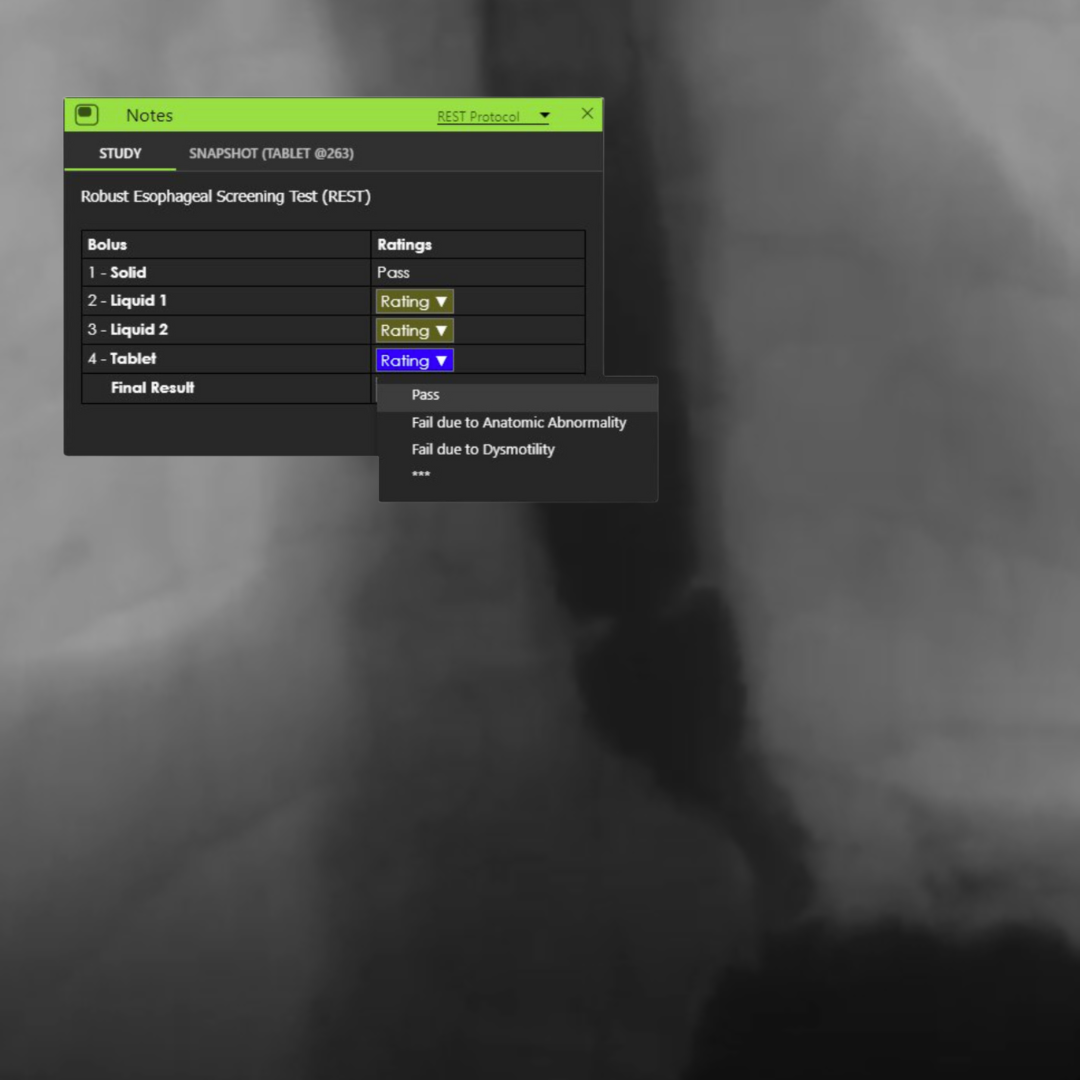TIMS Resources
Analysis Methods
Promote standards of care and improve patient outcomes.
TIMS MVP integrates advanced analysis methods and tools aimed at elevating standards of care, enhancing efficiency, fostering collaboration, and ultimately improving patient outcomes.
Explore below to discover the comprehensive suite of tools available within TIMS MVP, including downloadable scorecards, label sets, and notes, designed to support detailed and insightful analysis in clinical settings.
BaByVFSS Impairment Profile (BaByVFSSImP)
The BaByVFSImP™ aims to standardize the interpretation and communication of Videofluoroscopic Swallow Studies (VFSS) results for bottle-fed infants. It was developed to establish a reliable metric for assessing swallowing impairment based on VFSS exams guided by clinical judgment. While its validation pertains specifically to thin liquids, scoring additional consistencies when clinically indicated may offer deeper insights into swallow physiology and impairments. When assessing babies with both thin liquids and other consistencies, it is crucial to base the overall impression score solely on their performance with thin liquids. The assessment encompasses 21 swallow components; each scored according to a standardized metric integral to the BaByVFSImP™ methodology.
Learn more →
Dynamic Imaging Grade of Swallowing Toxicity (DIGEST) for MBSS and FEES
The Dynamic Imaging Grade of Swallowing Toxicity (DIGEST) is a validated system designed to evaluate the severity of pharyngeal swallowing impairment. Originally developed for videofluoroscopy in patients with cancer, DIGEST has since been validated for use in other populations, including those with neurological conditions causing dysphagia and acute care settings. DIGEST has also been adapted for use in FEES (DIGEST-FEES).
Learn more →
Eating Assessment Tool (EAT-10)
The Eating Assessment Tool (EAT-10), developed by Belafsky et al. (2008) is a 10-item, self-administered, symptom-specific outcome instrument for dysphagia. It is used to identify individuals at a high risk of swallowing disorders. Each item corresponds to 5 levels of difficulty ranging from “no problem” to “serious problem,” with a total score of 0 to 40. The EAT-10 demonstrates correlation between scores and pharyngeal residue, penetration, and aspiration as identified by FEES and MBS.
Functional Oral Intake Scale (FOIS)
The Functional Oral Intake Scale (FOIS) developed by Crary et al. (2005) is an ordinal scale with seven tiers that assess the oral intake of food and liquids. It is a commonly used scale for the rating of the range of oral intake for individuals with dysphagia and is used in both clinical practice and research settings. The FOIS demonstrates adequate reliability, validity, and sensitivity to change in functional oral intake.
Modified Barium Swallow Impairment Profile (MBSImP™©)
The Modified Barium Swallow Impairment Profile (MBSImP) is a standardized method for teaching, assessing, and reporting physiological swallowing impairments based on observations from the MBS study. It covers the assessment of 17 components of the adult swallowing mechanism and includes a scoring system to objectively profile these impairments. The MBSImP enables clinicians to communicate MBS study results in a consistent, specific, accurate, and evidence-based manner.
New Zealand Secretion Scale (NZSS)
The New Zealand Secretion Scale (NZSS) is utilized to assess accumulated secretions during endoscopy. Secretions are rated under the categories of location, amount, and response. The NZSS is a reliable tool to assess secretion severity during endoscopy that can be used without training.
Penetration-Aspiration Scale (PAS)
The Penetration–Aspiration Scale (PAS) is a widely used tool for identifying and rating the severity of penetration and aspiration events. It is a rank-ordered scale that classifies the depth of the penetrated or aspirated material and the patient’s response to the airway invasion.
Although frequently used for videofluoroscopy, the PAS further demonstrates excellent inter- and intrarater reliability in its use with FEES.
Reflux Finding Score (RFS)
The Reflux Finding Score is an 8-item severity rating scale assessed via endoscopy. This scale includes the most prevalent laryngeal changes secondary to laryngopharyngeal reflux (LPR). Those that score higher than 7 have more than 95% likelihood of having LPR. The RFS demonstrates excellent inter- and intra-observer reproducibility.
Reflux Symptom Index (RSI)
The Reflux Symptom Index (RSI) is a validated self-administered nine-item outcomes instrument for laryngopharyngeal reflux (LPR). It is an easily administered tool that demonstrates excellent construct and criterion-based validity. The RSI can be beneficial in the early diagnosis of LPR.
Revised Patterson Edema Scale
The Revised Patterson Edema Scale is a revision to the original Patterson Edema scale developed in 2007 which was created to tackle the lack of a reliable, sensitive scale to measure laryngeal and pharyngeal edema for those with head and neck cancer. The Revised Patterson Scale has demonstrated moderate-substantial interrater reliability for a majority of the parameters it assesses across experience levels and multiple disciplines. Experts report that it offers a reliable tool for both clinicians and researchers to rate edema in the supraglottic larynx and pharynx after the conclusion of treatment for head and neck cancer.
Robust Esophageal Screening Test (REST)
The Robust Esophageal Screening Test (REST) is a validated and standardized esophageal screening protocol, that is beneficial in specifying and expediting next steps for multidisciplinary teams. The REST demonstrates high sensitivity and specificity for detecting esophageal abnormalities. Additionally, a quality improvement project (QIP) revealed the feasibility of implementation.
Yale Pharyngeal Residue Severity Rating Scale
The Yale Pharyngeal Residue Severity Rating Scale is a standardized, validated, and reliable tool used to determine residue location and severity based on flexible endoscopic evaluation of swallowing (FEES). It is an anatomically defined, image-based assessment that utilizes a five-point ordinal rating scale based on residue location and amount.












